Swimming is a fantastic sport that offers numerous health benefits and is a great way to stay fit.
Whether you are a competitive swimmer or a recreational swimmer, mastering the swimmer position is essential to improve your stroke techniques and enhance your overall performance in the water.
In this article, we will explore the importance of the swimmer position in swimming and provide you with valuable tips on how to achieve the perfect swimmer position while swimming.
The Importance of the Swimmer Position in Swimming
The swimmer’s position serves as the foundation for efficient swimming technique.
It is the starting point for every stroke, and without a proper swimmer position, your strokes will lack power and efficiency.

When you maintain the correct swimmer position, you minimize drag and resistance, allowing you to move through the water with ease.
This helps you conserve energy and swim faster, ultimately leading to improved performance in the pool.
Key Components of a Swimmer Position in Swimming
To achieve the perfect swimmer position, you need to focus on four key components:
- Body alignment: Body alignment refers to maintaining a straight line from your head to your toes, with your body parallel to the surface of the water.
-
Head position: Your head should be in a neutral position, looking straight ahead
-
Hand placement: Your hands should be extended in front of you, shoulder-width apart
- Leg positioning: Finally, your legs should be straight and close together, with your toes pointed.
How to Achieve the Perfect Swimmer Position while Swimming
To achieve the perfect swimmer position, start by:
-
Practicing proper body alignment on dry land. Stand tall with your shoulders back, and imagine a straight line extending from the top of your head to your feet. Engage your core muscles to maintain this alignment.
-
Next, Practice extending your arms in front of you, shoulder-width apart, with your palms facing down. Focus on keeping your head in a neutral position, and visualize yourself swimming through the water with ease.
-
Lastly, work on keeping your legs straight and close together, with your toes pointed. By practicing these elements on land, you will be better prepared to achieve the perfect swimmer position in the water.
Importance of the Swimmer Position in Freestyle Stroke Swimming
The swimmer’s position is crucial in every swimming stroke, and the freestyle stroke is no exception. In freestyle, the swimmer position allows you to maximize your propulsion and minimize drag.
To position yourself correctly for the freestyle stroke, start by standing tall in the water with your arms extended in front of you.
As you begin your stroke, reach forward with one arm while simultaneously extending the other arm backward.
This alternating arm motion, combined with proper body alignment, will allow you to maintain an efficient swimmer position and propel yourself through the water with speed and grace.
How Does a Swimmer Position Themselves to Start the Freestyle Technique?
To start the freestyle technique, a swimmer positions themselves by diving into the water from a starting block or pushing off from the wall.

As you prepare to dive or push off, crouch down with your feet shoulder-width apart and your arms extended in front of you.
Visualize your target and explode off the starting block or wall, extending your body into a streamlined position.
As you enter the water, maintain the swimmer position by extending your arms forward and aligning your body from head to toe. This streamlined position will help you minimize drag and maximize your speed as you begin your freestyle technique.
Importance of the Swimmer Position in Backstroke Swimming
In backstroke swimming, the swimmer’s position is equally important. It allows you to maintain balance in the water, streamline your body, and generate power with each stroke.
To achieve the swimmer position for backstroke, start by floating on your back with your arms extended above your head and your legs straight and close together.
Your body should be aligned parallel to the surface of the water. By maintaining this position, you minimize resistance and maximize your efficiency while swimming backstroke.
READ ALSO: Everything You Need to Know About Sprinting in Swimming
How Do Swimmers Position Themselves to Start the Backstroke Technique?
To start the backstroke technique, a swimmer positions themselves by pushing off from the wall or diving into the water.
As you prepare to start, position yourself near the wall with your back facing the water. Extend your arms straight above your head and cross your hands, with your thumbs interlocked.
Push off from the wall or dive into the water, keeping your body aligned and your legs straight.
As you enter the water, extend your arms behind you while maintaining the swimmer position. This will allow you to generate power and maintain efficiency as you execute the backstroke technique.
Importance of the Swimmer Position in Breaststroke Swimming
The swimmer position is vital in breaststroke swimming as it enables you to generate power, maintain balance, and streamline your body.

In breaststroke, the swimmer position involves a unique arm and leg motion that requires proper alignment to ensure efficient swimming.
By maintaining a correct swimmer position, you minimize resistance and maximize your propulsion in the water, leading to improved performance.
How Do Swimmers Position Themselves to Start the Breaststroke Technique?
To start the breaststroke technique, a swimmer positions themselves by pushing off from the wall or diving into the water.
As you prepare to start, crouch down with your knees bent and your feet together. Place your hands in front of you with your palms facing down, and extend your arms forward.
Push off from the wall or dive into the water, keeping your body aligned and your legs straight.
As you enter the water, maintain the swimmer position by extending your arms forward and your legs backward.
This streamlined position will help you generate power and maintain efficiency throughout the breaststroke technique.
Importance of the Swimmer Position in Butterfly Stroke Swimming
The swimmer position is crucial in butterfly stroke swimming as it allows you to generate power, maintain balance, and streamline your body.

In butterfly, the swimmer position involves a simultaneous arm and leg motion that requires proper alignment to ensure efficient swimming.
By maintaining a correct swimmer position, you minimize resistance and maximize your propulsion in the water, leading to improved performance.
READ ALSO: How to Improve Your Technique and Conquer the Challenge of Swimming 200 Yards
How Do Swimmers Position Themselves to Start the Butterfly Stroke Technique?
To start the butterfly stroke technique, a swimmer positions themselves by pushing off from the wall or diving into the water.
As you prepare to start, crouch down with your feet shoulder-width apart and your arms extended in front of you.
Push off from the wall or dive into the water, keeping your body aligned and your legs straight.
As you enter the water, maintain the swimmer position by extending your arms forward and your legs backward.
This streamlined position will help you generate power and maintain efficiency throughout the butterfly stroke technique.
Common Mistakes to Avoid in the Swimmer Position while Swimming
While striving to achieve the perfect swimmer position, it is important to be aware of common mistakes that can hinder your progress:
- Allowing your head to lift too high, disrupting your body alignment.
- Dropping your hips, which creates unnecessary drag.
- Additionally, a common mistake is not extending your arms fully, resulting in decreased propulsion.
By being mindful of these mistakes and focusing on proper technique, you can avoid these pitfalls and improve your swimmer position.
Training Exercises to Improve Your Swimmer’s Position Before a Swim Race
To improve your swimmer position before a swim race, there are several training exercises you can incorporate into your swimming routine:
- One effective exercise is the Superman drill, where you float on your stomach with your arms extended in front of you and your legs straight and close together.
- Another beneficial exercise is the streamline kick drill, where you practice kicking on your back while maintaining a straight body alignment.
By consistently incorporating these exercises into your training, you can strengthen your core muscles, improve your body alignment, and enhance your swimmer position.
Tips for Maintaining the Swimmer Position throughout a Swimming Race
Maintaining the swimmer position throughout a swimming race is essential for optimal performance. To ensure you maintain the correct position:
-
Focus on your body alignment and head position. Keep your body parallel to the surface of the water and your head in a neutral position, looking straight ahead.
- Pay attention to your hand placement and leg positioning. Keep your hands extended in front of you, shoulder-width apart, and your legs straight and close together.
By consistently reminding yourself of these key components, you will be able to maintain the swimmer position and maximize your performance throughout the race.
READ ALSO: Causes, Prevention, and Effective Treatment Methods of Swimming Neck Pain
Conclusion and Final Thoughts
Mastering the swimmer position is crucial for improving your stroke techniques and enhancing your overall performance in swimming.
By understanding the importance of the swimmer’s position in each stroke, learning how to position yourself correctly for each technique, and avoiding common mistakes, you can achieve a more efficient and powerful swim.
Remember to incorporate training exercises to strengthen your swimmer position and maintain proper alignment during races.
By consistently practicing and refining your swimmer position, you will become a more proficient swimmer and experience the joy of swimming to its fullest potential.
To read more answers to difficult sports questions, subscribe to our newsletter.
Subscribe to our newsletter!
Stay informed, learn new techniques, and become a better athlete.
